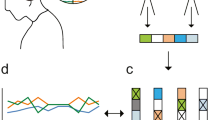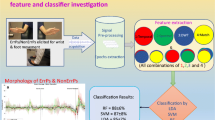Abstract
The aim of this paper is to present a classification method that is capable to discriminate between Event Related Potentials (ERPs) that are the result of observation of correct and incorrect actions. ERP data from 47 electrodes were acquired from eight volunteers (observers), who observed correct or incorrect responses of subjects (actors) performing a special designed task. A number of histogram-related features were calculated from each ERP recording and the most significant ones were selected using a statistical ranking criterion. The Support Vector Machines algorithm combined with the leave-one-out technique was used for the classification task. The proposed approach discriminated the two classes (observation of correct and incorrect actions) with accuracy 100%. The proposed ERP-signal classification method provides a promising tool to study observational-learning mechanisms in joint-action research and may foster the future development of systems capable of automatically detecting erroneous actions in human-human and human-artificial agent interactions.
Access this chapter
Tax calculation will be finalised at checkout
Purchases are for personal use only
Preview
Unable to display preview. Download preview PDF.
Similar content being viewed by others
References
Petrosini, L., Graziano, A., Mandolesi, L., Neri, P., Molinari, M., Leggio, M.G.: Watch how to do it! New advances in learning by observation. Brain Res. Rev. 42, 252–264 (2003)
van Schie, H., Mars, R.B., Coles, M.G.H., Bekkering, H.: Modulation of activity in medial frontal and motor cortices during error observation. Nature Neurosci. 7, 549–554 (2004)
Scheffers, M.K., Coles, M.G.: Performance monitoring in a confusing world: Error-related brain activity, judgments of response accuracy, and types of errors. J. Exp. Psychol. Human 26, 141–151 (2000)
Ventouras, E.M., Asvestas, P., Karanasiou, I., Matsopoulos, G.K.: Classification of Error-Related Negativity (ERN) and Positivity (Pe) potentials using kNN and Support Vector Machines. Comput. Biol. Med. 41, 98–109 (2011)
Sveinsson, J.R., Benediktsson, J.A., Stefansson, S.B., Davidsson, K.: Parallel principal component neural networks for classification of event-related potential waveforms. Med. Eng. Phys. 19, 15–20 (1997)
Palaniappan, R., Paramesran, R.: Using genetic algorithm to identify the discriminatory subset of multi-channel spectral bands for visual response. Appl. Soft. Comput. 2, 48–60 (2002)
Kalatzis, I., Piliouras, N., Ventouras, E., Papageorgiou, C.C., Rabavilas, A.D., Cavouras, D.: Design and Implementation of an SVM-based Computer Classification System for Discriminating Depressive Patients from Healthy Controls using the P600 Component of ERP Signals. Comput. Meth. Prog. Biol. 75, 11–22 (2004)
van Schie, H., Mars, R.B., Coles, M.G.H., Bekkering, H.: Modulation of activity in medial frontal and motor cortices during error observation. Nat. Neurosci. 7, 549–554 (2004)
Duda, R.O., Hart, P.E., Stork, D.G.: Pattern Classification. John Wiley & Sons, Inc., New York (2001)
Montgomery, D.C., Rumger, G.C.: Applied Statistics and Probability for Engineers. John Wiley & Sons, Inc., New Jersey (2003)
Steinwart, I., Christmann, A.: Support Vector Machines. Springer (2008)
Schenker, B., Agarwal, M.: Cross-validated structure selection for neural networks. Comput. Chem. Eng. 20, 175–186 (1996)
Author information
Authors and Affiliations
Editor information
Editors and Affiliations
Rights and permissions
Copyright information
© 2013 Springer-Verlag Berlin Heidelberg
About this paper
Cite this paper
Asvestas, P., Ventouras, E.M., Karanasiou, I., Matsopoulos, G.K. (2013). Classification of Event Related Potentials of Error-Related Observations Using Support Vector Machines. In: Iliadis, L., Papadopoulos, H., Jayne, C. (eds) Engineering Applications of Neural Networks. EANN 2013. Communications in Computer and Information Science, vol 384. Springer, Berlin, Heidelberg. https://doi.org/10.1007/978-3-642-41016-1_5
Download citation
DOI: https://doi.org/10.1007/978-3-642-41016-1_5
Publisher Name: Springer, Berlin, Heidelberg
Print ISBN: 978-3-642-41015-4
Online ISBN: 978-3-642-41016-1
eBook Packages: Computer ScienceComputer Science (R0)




